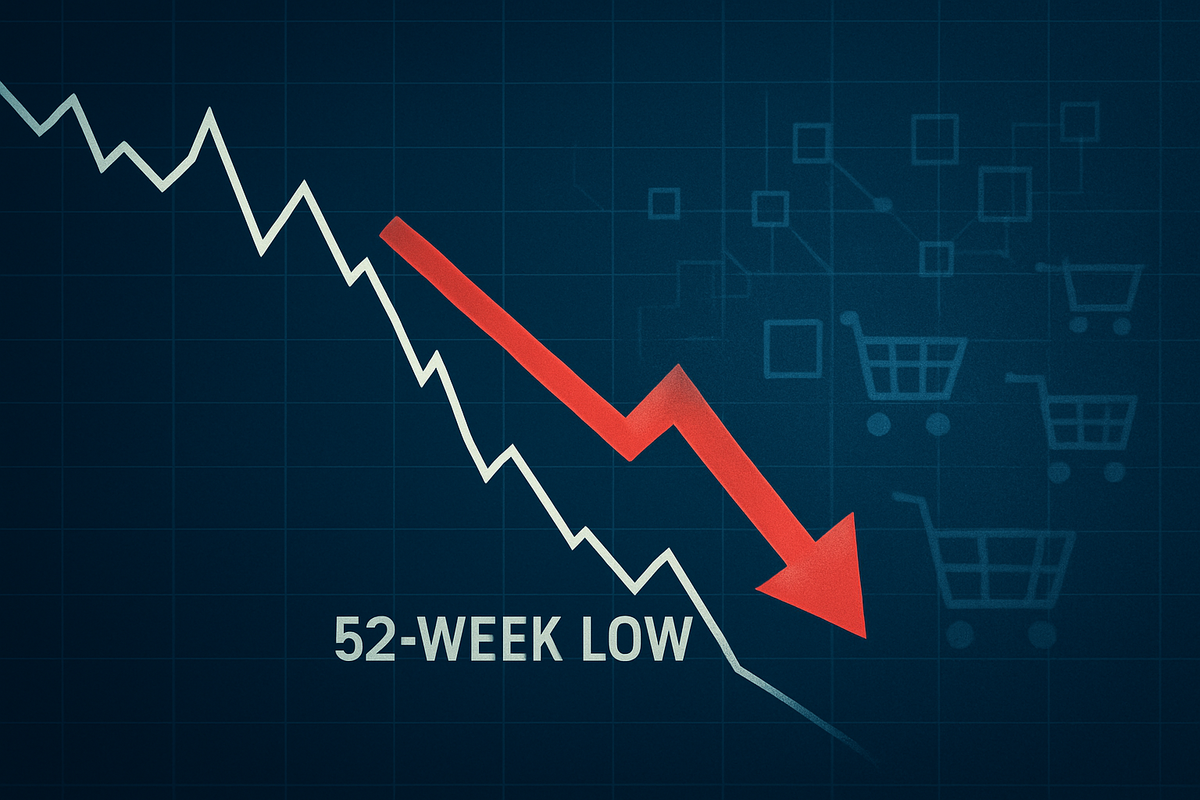
Minneapolis, MN – November 1, 2025 – SPS Commerce (NASDAQ: SPSC), a leading provider of cloud-based supply chain management solutions, experienced a significant downturn on October 31, 2025, with its stock plummeting to a new 52-week low. The sharp decline followed a series of analyst downgrades and a disappointing third-quarter earnings report, which included a revenue miss and a weaker-than-expected outlook for the coming quarters. This event has sent ripples through the retail technology sector, raising questions about the company's growth trajectory and the broader health of enterprise software spending amidst macroeconomic headwinds.
The immediate implications are a significant hit to investor confidence and a re-evaluation of SPS Commerce's valuation. The stock's dramatic fall, wiping out a substantial portion of its market capitalization in a single day, underscores the market's sensitivity to growth deceleration, particularly for companies that have historically commanded premium valuations based on their strong growth prospects.
Detailed Coverage: A Storm of Downgrades and Missed Expectations
The catalyst for SPS Commerce's recent troubles was its Q3 2025 earnings report, released on October 30, 2025. While the company reported an adjusted EPS beat, its revenue of $189.9 million fell short of analyst expectations of $192.68 million. The real concern, however, stemmed from the company's forward-looking statements. SPS Commerce issued weaker guidance for Q4 2025, forecasting revenue between $192.7 million and $194.7 million, significantly below the Street's consensus of $199.9 million. Furthermore, its initial 2026 growth outlook projected revenue growth of 7%-8%, a notable deceleration from its historical performance and below prior analyst expectations of around 9%. The company also cut its full-year 2025 sales guidance.
In response to these developments, several prominent analyst firms swiftly downgraded their ratings and slashed price targets for SPS Commerce. On October 31, 2025:
- Cantor Fitzgerald downgraded SPSC from "Overweight" to "Neutral" and drastically cut its price target from $135 to $80.
- Stifel followed suit, downgrading the stock from "Buy" to "Hold" and lowering its price target from $150 to $80.
- Needham maintained a "Buy" rating but reduced its price target from $160 to $110, reflecting a more cautious outlook.
- DA Davidson also moved its rating from "Buy" to "Neutral" and cut its price target to $80.
Analysts cited a confluence of factors for the downgrades and the company's underperformance, including "myriad headwinds." These encompass macroeconomic challenges, increased scrutiny on retail spending, and structural headwinds in retail supply chain demand. Management also acknowledged internal operational issues such as delayed relationship management campaigns with retailers, continued supplier challenges, and unforeseen seasonality in its newer Revenue Recovery business. The immediate market reaction was severe, with shares of SPS Commerce experiencing an approximate 20-25% drop in after-market and intraday trading on October 31, reaching a 52-week low.
Company Impact: Navigating Headwinds and Rebuilding Trust
The analyst downgrades and weak guidance represent a significant setback for SPS Commerce (NASDAQ: SPSC), impacting its market position, future growth prospects, and critically, investor confidence. As a leader in cloud-based supply chain management and Electronic Data Interchange (EDI), connecting over 120,000 trading partners globally, SPS Commerce has historically enjoyed robust growth. However, the current "spend scrutiny in the retail ecosystem" suggests that its core customer base may be tightening budgets or delaying investments in new software, directly affecting SPS Commerce's ability to expand its network and service offerings.
The most immediate impact on growth prospects is the projected deceleration in revenue, with the 7%-8% outlook for 2026 marking a significant step down from its historical performance, which saw growth rates of 18-21% in previous quarters. This shift indicates either a more mature market or increased difficulty in acquiring new clients, leading the company to focus more on increasing average revenue per user (ARPU) from existing clients. While the company expects adjusted EBITDA margin expansion, this focus on profitability and cost control comes at a time of slower top-line growth.
Investor confidence has taken a substantial hit, evidenced by the sharp stock price decline and the drastic cuts in price targets by analysts. The shift from "Buy" to "Hold" or "Neutral" ratings signals a cautious approach, with analysts awaiting clearer signs of stabilization. Concerns about SPS Commerce's "overleveraged valuation" and high PEG ratio, relative to its revised growth expectations, have also emerged. The company's announcement of a $100 million share repurchase program, typically a positive signal, has yet to fully offset the pervasive negative sentiment.
For competitors in the EDI and supply chain software space, such as TrueCommerce EDI, Cleo Integration Cloud, Boomi, and MuleSoft Anypoint Platform, SPS Commerce's challenges could present opportunities. If the issues are company-specific, rivals might gain market share. However, if the "macro headwinds" and "spend scrutiny" are pervasive across the retail ecosystem, then competitors may also face similar pressures. Partners, including the vast network of retailers and suppliers relying on SPS Commerce, could face uncertainty. A prolonged slowdown or service degradation, though not currently indicated, could prompt them to explore alternative solutions for their critical supply chain data exchange.
Wider Significance: A Bellwether for Retail Tech and Enterprise Spending
The recent downturn at SPS Commerce (NASDAQ: SPSC) is more than an isolated corporate event; it serves as a significant indicator for broader trends within the retail technology and supply chain software sectors. The challenges cited by analysts and management – macroeconomic pressures and increased scrutiny on retail spending – resonate with the wider narrative of a tightening economic environment impacting enterprise software investments. This event suggests that even established players in critical infrastructure like supply chain management are not immune to the effects of a "retail recession sequel," where consumers prioritize essentials and retailers consequently trim discretionary spending.
While the overall Supply Chain Management (SCM) software market is projected for robust growth, driven by digital transformation, e-commerce expansion, and demand for greater visibility, SPS Commerce's performance indicates a potential disconnect or a slower adoption rate for certain offerings amidst economic tightening. The event also highlights the ongoing pressure on the broader IT Services sector, where macroeconomic fears are dampening enterprise software spending. This could lead to increased scrutiny from investors on other retail tech and supply chain software companies, especially those with high valuations or similar exposure to discretionary retail spending, potentially triggering a re-evaluation of growth expectations across the sector.
Historically, economic downturns have often exposed vulnerabilities and accelerated existing trends in retail and enterprise software. The dot-com bubble in the early 2000s saw a similar "flurry of software company downgrades" as IT spending contracted. More recently, companies like ASML faced supply chain problems, though their issues were more related to material shortages than customer spending. The current situation with SPS Commerce underscores how external economic factors can directly impact technology providers serving critical sectors.
While the downgrade is primarily a market and business performance issue, it could indirectly touch upon regulatory and policy discussions. Governments are increasingly focused on supply chain resilience and transparency, with regulations like the U.S. Uyghur Forced Labor Prevention Act (UFLPA) demanding greater traceability. If a major EDI provider faces prolonged challenges, it could expose fragilities in the digital infrastructure supporting these compliance efforts, potentially prompting calls for greater standardization or public-private partnerships. Furthermore, any significant market concentration resulting from struggles among smaller firms could draw antitrust scrutiny.
What Comes Next: Strategic Pivots and Market Evolution
In the short term, SPS Commerce (NASDAQ: SPSC) faces the critical task of stabilizing investor confidence and demonstrating a clear path forward. The company will likely focus on operational adjustments, addressing the "unforeseen seasonality" in its Revenue Recovery business, and optimizing its "relationship management campaigns" with retailers. The recent appointment of Eduardo Rosini as the new Chief Commercial Officer, effective December 1, signals an immediate focus on driving customer lifecycle value and cross-sell initiatives to re-accelerate growth. Despite the pressures, the company's recurring revenue model and strong financial health provide a degree of insulation.
Longer-term, SPS Commerce's strategy will likely center on leveraging its extensive retail network and established market leadership. Continued international expansion and deeper penetration into the supply chain management market are key objectives. The successful integration of recent acquisitions like Carbon6 and SupplyPike, which enhance offerings for Amazon sellers and invoice management, will be crucial for bolstering its market position. A significant pivot will involve the deeper integration of AI and automation across its platform, not just for operational efficiencies but also for providing advanced predictive analytics and value-added services to customers, a necessity in the evolving retail landscape.
Strategic adaptations for SPS Commerce may include enhancing its value proposition to retailers by emphasizing cost savings and efficiency gains, especially as spending scrutiny intensifies. Diversification beyond its core retail dependence, or at least a more proactive engagement with broader macroeconomic trends, could mitigate risks. For the broader retail tech sector, opportunities lie in the continued growth of omnichannel commerce, the increasing complexity of global supply chains, and the demand for data-driven decision-making. AI and Machine Learning adoption, sustainability solutions, and new retail technologies like augmented reality also present significant avenues for growth.
However, challenges persist, including persistent economic pressures, intense competition, and the rapid pace of technological change. Potential scenarios for SPS Commerce range from a best-case strategic recovery with accelerated growth driven by successful AI integration and market expansion, to a base-case of stable but moderated growth within the projected 7-8% range. A worst-case scenario could involve prolonged underperformance due to persistent macroeconomic challenges, integration struggles, or failure to innovate, leading to market share erosion and potentially making the company an acquisition target.
Wrap-Up: Navigating Uncertainty in a Dynamic Market
The recent analyst downgrades and subsequent plunge of SPS Commerce (NASDAQ: SPSC) to a 52-week low represent a critical juncture for the company and a significant event for the financial markets. The incident underscores the inherent volatility in the tech sector, particularly for growth-oriented companies heavily reliant on enterprise spending in a specific industry. Key takeaways include the market's unforgiving reaction to revenue misses and weak guidance, even from fundamentally sound companies, and the amplified impact of macroeconomic headwinds on discretionary IT spending.
Moving forward, the market will closely watch SPS Commerce's ability to execute on its strategic pivots, particularly its efforts to leverage AI, integrate acquisitions, and demonstrate sustained growth beyond its revised 2026 outlook. Investor confidence will hinge on tangible improvements in revenue acceleration and a clear articulation of how the company plans to navigate the "spend scrutiny" in the retail ecosystem. The event also serves as a reminder for investors to scrutinize valuations, especially for companies with high PEG ratios, in an environment where growth rates are decelerating.
What investors should watch for in the coming months includes the performance of SPS Commerce's Q4 2025 results relative to its lowered guidance, any updates on its 2026 outlook, and the effectiveness of its new Chief Commercial Officer in driving growth initiatives. Beyond SPS Commerce, the broader retail tech and supply chain software sectors will be under increased scrutiny, with investors looking for signs of resilience, innovation, and diversified revenue streams in the face of ongoing economic uncertainties. The lasting impact of this event will be determined by how SPS Commerce adapts to these challenges and whether its struggles are an isolated incident or a bellwether for a broader slowdown in enterprise software spending.
This content is intended for informational purposes only and is not financial advice




